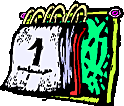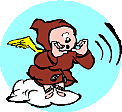With The Commentary of the RABAM


I strongly suggest you read this parsha at your own risk. "Why?" you ask, you minuval. Because a month hasn't even passed, and we are back at Pesach again. Reboinoisheloilum, I am still recovering from throwing my back out while removing the car seats from the mini van.
It's a good thing too I cleaned under the seats in the car -- my Yetzer Hara might have tempted me to break into the car after the second Seder to snack on the two crushed M&Ms on the floor.
Yetzer hara = Evil inclination. That which encourages man to do what is not good. The opposite of the Yetzer tov.
Second seder = because it is customary to celebrate two nights in a row. Traditionally, because dates are based on observation of the new moon, about which sometimes there is uncertainty due to the weather, one celebrates for two days just to be sure. No, your in-laws did not come up with this - but their ancestors who lived in Babylon did.
Why do we prepare so intensively for Pesach? According to Rabeinu Tam, we commemorate slavery in Egypt by spending six hours marching up and down the stairs to the attic to bring down the Pesach dishes while our wives stand over us barking orders (those amharatzois).
Rabbeinu Tam = Yaacov Ben Meir, a Talmud scholar who lived in France (1100 - 1171). He was the grandson of Rashi (1040 - 1105). Tam, which means straightforward or righteous in this context, was the characteristic ascribed to Yaacov the brother of Esav, so Rabbeinu Tam translates as 'our righteous rabbi'.
Peysach dishes = So that no chametz or even trace of chametz may be eaten, many people have a complete set of dishes used only at Peysach, in addition to the set given by their in-laws which they never use.
Meanwhile, rachmana litzlan, our wives absolutely exhaust themselves watching the cleaning lady prepare for Pesach.
Watching the cleaning lady prepare for peysach = and thus sharing the kedusha of our redemption, while imparting the misery felt by our ancestors while they were slaves. It’s a blessing.
The RAMBAM in Mishnah Torah asks an incisive question: Instead of selling our chametz to a goy, why can't we just temporarily sell our religion to a goy? This way, he can have the opportunity to get the mitzvah of celebrating Yetzias Mitzrayim, while we get to eat a little traifus, paint easter eggs, and have relations with a hot shiksa for seven days (eight days in Chutz La'aretz). But the RAMBAM concludes that if a goy had to eat Matzah for eight days, he would end up hating the Jews even more than he already does.
RAMBAM = Rabbi Moses Ben Maimon, also known as Maimonides (1135 - 1204), one of the greatest of exegetes and Talmudists ever, author of the 'Restating of Torah' (the Mishneh Torah, also know as the Yad Ha Chazaka - The Firm Hand, which is compendium of Jewish law meant to clarify practices in an overseeable format), Advice For The Perplexed (a philosophical work clarifying the elements of belief; look for it under 'self help'), many other books and responsa. His birthplace Cordova having become a tormentation, he went to Fez, then to Israel, before eventually settled in Egypt, where he was physician to the king and a leader in the Jewish community. He is buried in Teveria (Tiberias). Truly one of the most impressive scholars ever, his works have also been read by Gentiles for over five centuries now (although at one time they were banned and burned).
Chametz = Leavened substances forbidden during Passover, when in commemoration of the haste with which our ancestors left Egypt, we eat unleavened bread (matza). It is forbidden to have chametz in ones possession during Passover, hence many sell theirs to a goy (gentile). This is something that can be properly arranged through a rabbi, if you wish to buy it back once all the fuss is over. But it is better to simply sell it with no thought of repurchase, unless it is needed for business.
The Mitzvah of celebrating Yetzias Mitzrayim = The commandment (mitzva) of celebrating the redemption (yetzias) from Egypt (mitzrayim). The Aybishter pulls us up out of Egypt…. And then has us running around a desert for a generation. I'm of two minds about this.
Painting Easter eggs = Eggs, painting? What kind of thing is this? This is simchas? Truly the ways of the goyim are mysterious.
Shiksa = A gentile female, which is something that my basherte will never hear abo…, urhgh, I mean, Baruch atta Adonai Eloheinu, Melech ha-olam, Oseh ma'aseh bereishis!
"End up hating the Jews even more than he already does" = A truly perverse form of self-hatred. While 'That Man' had unconventional ideas, his devotee Paul the meshumid was truly revolutionary. Rather than follow the Notzri, who did everything in his power to piss-off the Romans while twirling his payis, the gentiles chose to follow Paul, who was more Roman than a Caesar Salad in a public bathhouse. And those who follow Paul are more Paul than Paul. Dysfunctional is a term that comes to mind (and Greek, enough said). So does 'Baruch atta Adonai, Melech ha olam, shelo asani goy'.
In truth, why do we stop our Peshach cleaning at our abode and our cars? A Gemarrah In Masheches Peshachim daff chuff aleph, amud baiz asks: Why don't we clean out our bodies of the Chometz we pump into them 51 weeks a year? Indeed, Rav Ashi holds that this is the reason that bechorim fast Erev Pesach, and that to get the full mitzvah, people should stick their finger's down their throats during bedikas chometz.
Gemara = Something to learn; a teaching, a tale, a discussion.
Maseches Pesachim = The Talmud tractate which details the laws of Passover. The first chapter deals specifically with getting rid of chametz.
Bechorim fasting on Erev Pesach = In remembrance of the redemption of the first-born of Israel, and the whacking of the first-born of Egypt.
Bedikas chometz = Hunting down and killing yeast wherever it may hide. More rationally, making sure that all chametz is out of your possession by teatime on erev peysach (Passover-eve). Teatime is the fourth hour, by the way. Don't spoil dinner by gorging on scones and preserves. Dinner is important.
And note that many alcoholic beverages are also chametz, in that they are made with leavened materials – you may want to manage your liquor cabinet wisely in the months leading up to peysach, but Purim was a golden opportunity to diminish your supply of chametz which it would have been wise to have taken full advantage of.
But further in the Gemarra, Rav Yosi disagrees, saying that since the food is already eaten, we hold that food cannot be eaten a second time, so there is no such requirement. However, Rav Yosi does go on to tell a story of how one year he told his wife that he needed her help cleaning for Pesach, since halacha required him to expel ALL possible bodily fluids. And due to her extreme gullibility, she helped him three times that night. What an Aishess Chayill. Unfortunately, he slept through much of the seder the next night, so he never dared to do it again.
Aishes Chayill = An accomplished woman - who can find such, her value is greater than rubies!
My personal belief is that celebrating Yetzias Mitzrayim is a wonderful opportunity to spend time with the einiklach. Beyond cleaning, you get the mitzvah of preparing the matzois and the ka'arah. During the Seder you are unified with all of Klal Yisroel in celebration. And after the Seder, while cleaning up, you lament the fact that your damn sister-in-law wasn't accidentally left in Mitzrayim.
Ka'arah = The Seder Plate, on which three matzos, a roast egg, a lamb-bone, parsley, chreyn, charoses, and salt water - all have a symbolic meaning. The matze are the bread of our affliction (the obligation is two complete loaves - leihem mishnei, and a third to break), the lamb-bone recalls the Pascal sacrifice whose blood was spattered on our lintels so that HaShem would spare us while slaughtering the first-born of Egypt, the parsley is the green of spring (the season of our redemption), the chreyn is the bitterness of our sojourn in Mitzrayim, the charoses is the mortar with which we built Pharaoh's monuments, and the salt water is our weeping in Mitrayimish misery. The egg, which is rebirth and perfection, also represents the Yontef offering in the temple, which will eventually be rebuilt.
Left in Mitzrayim = This is to remind us of the misery of our Egyptian bondage, the agony we endured, and the suffering of our subsequent wandering in the wastelands of Sinai.
Sister in Law = Two of the sons of Moses’ sister-in-law were zapped for lighting funky fire in front of the Mishkan. Hopheads! Should have stayed in Egypt!
But the timing of this week's Parsha raises a key question about the overall structure of the parshiyois of the Toirah: Why don't they follow a more intutive order? Why does the Toirah place individual sections out of chronological order, as well as offer multiple repetitions of various episodes and sections?
Parshayos = The fifty four sections of the Torah.
The standard answer, given by Rashi, is that Moishe Rabbeinu, like any good representative of Klal Yisroel, never went anywhere without his cell phone. And as the Reboinoisheloilum was dictating the Toirah, his menuval brother Aron Hacoihain kept on calling. "Moishe, should I have the people pray?" "Moishe, should we circle Har Sinai?" "Moishe, white makes me look fat; can you ask the Aimishteh to change the color of the Koihain Gadol's garments?" Well all of these constant distractions threw Moishe off, and he got the order of the Reboinoisheoloilum's dictation all confused.
Moishe Rabbeinu = Moses our teacher. Klal Yisroel = The descendants of Yaakov, who strove with G-d, which is what the name Yisroel means. Ribonoshelolam = G-d.
Menuval = Disreputable fellow. Har Sinai = The mountain on which G-d spoke to Moses, at the foot of which the menuval brother made an idol ha zahav.
I would humbly like to offer a new pshat. I remember as a young talmid I asked my rebbe muvhak, the NPOJHARTHA, why we learned mussar in the morning, gemarra all day, and NACH with mepharshim at night -- shouldn't we study in the reverse order, reflecting the development of Toirah and lumduss? The NPOJHARTHA glowingly gave me a hug, led me by the hand to the front of the bais medrish, and then slammed my head against the top of his shtender. "Until you know the answers yourself, don't ask me such stupid questions, you vilda chaya" he then said.
But during peysach we encourage the asking of stupid questions. Rachmana litzlan, what we have to put up with - why didn't you buy a station wagon like I told you, why haven't you been promoted yet, when are you going to buy a bigger house, why can't you be like your brother? And so on. In addition to little kinderlech asking about the meaning of this night, which is actually quite charming, I'm beaming with pride.
Rebbe muvhak = The Rebbe who is the learner’s guide through the intricacies of Talmud-Torah, who is like a father to his talmidim. Muvhak = Special, distinct, well-known. The student of such a teacher is a talmid muvhak. The benefit of such a relationship is that it instills a comprehensively unified set of knowledge in the student, tailored over time to the particularities of the student in question. Only great teachers become rebbeyim-muvhakim.
After pondering this comment for thirty years, I now understand my rebbe's wisdom. Mimunifshuch, if everything in life made sense, we wouldn't have to daven three times a day. Life is confusing. And those of us who don't fall into the trap of seeing everything in black and white must spend our lives struggling with shades of gray.
So the Toirah has a few mysteries. If everything was crystal clear, faith wouldn't be a challenge.
Mimunifsuch = For Chrissakes
Daven = Pray.
Three times a day = The daily cycle of prayer, starting when the day begins, Maariv (evening - the day begins at nightfall), then in early morning (Shacharis), and finally in the afternoon (mincha). The most important individual prayer is the eighteen benedictions (Shmoneh Esrei), of which there are actually nineteen. It is known as the standing prayer.
The Reboinoishelolum wants to keep us guessing and asking questions.
And at the same time, he intends the Toirah to serve as our road map. So don't complain next time you have to vacuum the inside of the car and don't know why. At least as a member of Klal Yisroel you are never expected to change a tire by yourself.
Ah Gutten Shabbos, You Minuval.



